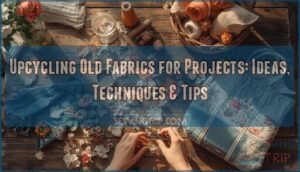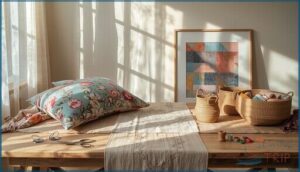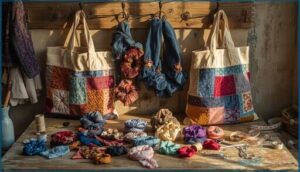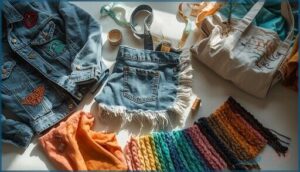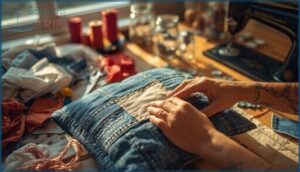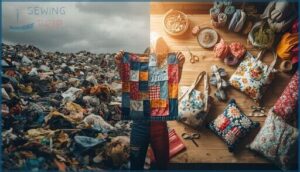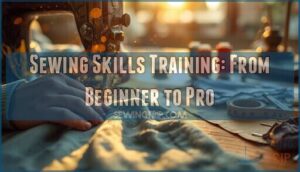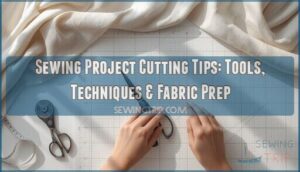This site is supported by our readers. We may earn a commission, at no cost to you, if you purchase through links.
That drawer full of worn-out T-shirts and faded curtains? It’s not clutter—it’s raw material waiting for a second act. Upcycling old fabrics for projects transforms what would’ve landed in a dumpster into something useful, beautiful, and entirely yours.
The best part isn’t just keeping textiles out of landfills (though the average person tosses 81 pounds of clothing annually). It’s the freedom to create without spending a dime on new fabric. Whether you’ve got sewing skills or prefer a needle-free approach, old fabrics offer endless possibilities for home decor, accessories, and one-of-a-kind gifts.
You’ll discover how to choose the right materials, master simple techniques, and turn forgotten textiles into projects you’ll actually want to show off.
Table Of Contents
Key Takeaways
- Upcycling old fabrics keeps textiles out of landfills (Americans trash 81 pounds annually) while giving you free raw materials for home decor, accessories, and gifts without needing advanced sewing skills.
- Start by sourcing fabrics from your closet or thrift stores, then wash and sort by fiber type, weight, and color—quality materials with tight weaves and minimal defects transform into projects that actually last.
- You can slash crafting costs by 30% while tapping into the booming upcycled fashion market (projected to hit $16.70 billion by 2032), proving sustainable choices deliver both environmental impact and real profit margins.
- Master simple techniques like straight stitches for beginners or no-sew methods using fabric glue and scissors, then add visible mending with decorative patches to turn worn spots into creative statements.
Choosing Fabrics for Upcycling Projects
You can’t upcycle every fabric the same way, and knowing where to look makes all the difference. The best materials are often hiding in your own closet or at local secondhand shops, but they need a bit of prep work before you start cutting and sewing.
Here’s what to keep in mind when choosing fabrics that’ll actually work for your next project.
Best Sources for Old Fabrics
You don’t need to look far to find great fabric scraps for upcycling. Start with your own closet—old clothes you’re ready to part with are perfect candidates.
Check out thrift stores and secondhand shops where textile recycling potential is everywhere. Online marketplaces connect you with fabric remnants and deadstock from local donations. Even charity bins often redirect materials your way, giving scrap fabric a second life.
By adopting a textile waste reduction strategy, you can make a significant impact on the environment.
Preparing and Sorting Fabric Scraps
Once you’ve gathered your fabric scraps, organize them by type and color. Fabric sorting makes upcycling smoother—separate cotton from polyester, lights from darks. Wash everything at high heat to sanitize your textile recycling finds. Effective textile sorting strategies can help reduce waste.
Here’s a quick scrap classification system:
| Category | Examples |
|---|---|
| Natural fibers | Cotton, linen, wool |
| Synthetics | Polyester, nylon blends |
| Weight | Lightweight, heavyweight |
| Pattern | Solids, prints, textures |
| Size | Large remnants, small scraps |
This fabric preparation step sets you up for waste reduction success.
Tips for Selecting Quality Materials
Now that your scraps are sorted, let’s talk fabric sourcing strategy. Feel your materials—drape, stretch, and weight tell you what they can become. Look for tightly woven fabrics that resist fraying, like organic cotton or recycled linen with high sustainability ratings. Material testing doesn’t need fancy equipment:
- Check colorfastness by rubbing damp fabric on white cloth
- Examine texture analysis for pilling or wear spots
- Test structural integrity with a gentle pull
- Verify fiber content for repurposing materials compatibility
Quality fabric scraps transform upcycling from okay to exceptional.
Avoiding Fabrics With Defects
Beyond quality checks, defect detection saves your project from frustration. Around 32% of fabric test failures stem from poor fiber fastness—colors that bleed or fade ruin your work. Inspect for patent defects like holes, stains, or float stitches from improper weaving. Smart fabric inspection means checking both sides under good light, focusing on structural integrity.
Quality control for upcycling means choosing fabrics that’ll last through your creative vision.
| Defect Type | Visual Cue | Project Impact |
|---|---|---|
| Knots & Slubs | Bumpy texture | Weak seams |
| Oil Stains | Dark spots | Won’t wash out |
| Float Stitches | Loose threads | Unravels easily |
| Sun Fading | Uneven color | Patchy appearance |
| Poor pH Balance | Rough feel | Skin irritation |
Creative Upcycling Ideas for Old Fabrics
You’ve got your fabric sorted and ready—now comes the fun part. Whether you’re looking to refresh your space, create one-of-a-kind gifts, or breathe new life into your wardrobe, there’s an upcycling project waiting for every scrap.
Let’s explore some creative ways to turn your old textiles into something you’ll actually use and love.
DIY Home Decor Projects
Your home is a blank canvas waiting for some fabric magic. Transform old textiles into stunning DIY home decor that breathes new life into any room. Here are four popular upcycling ideas worth trying:
- Throw pillow covers from vintage scarves or linens (26% of shared projects)
- Framed fabric wall art using patterned scraps
- Table runners crafted from repurposed materials
- Soft storage baskets for stylish organization
These sustainable crafts save you money while keeping textiles out of landfills.
Handmade Accessories and Gifts
Small fabric pieces can become remarkable accessories that people actually want to receive. You can stitch together patchwork tote bags, craft unique scrunchies from denim scraps, or design one-of-a-kind brooches that showcase your style.
The handmade bags and upcycled jewelry market hit $151.5 billion in 2022, proving sustainable crafts aren’t just eco-friendly—they’re incredibly desirable fabric gifts that merge recycled fashion with personal creativity.
Easy Clothing Upcycle Ideas
Transform your wardrobe through clothing refashion and fabric recycling. T-shirt upcycling ideas like converting old tees into tank tops became 41% of all clothing upcycling projects in 2024. Jeans upcycling projects—featuring asymmetrical cuts and frayed edges—rose 29% last year.
These upcycled accessories and sustainable fashion choices let you practice textile reuse while saving thousands of liters of water per garment.
Fun Projects for Kids
Kid-friendly crafts turn textile scraps into treasured creations. In 2024, 64% of elementary programs included bracelet-making from old T-shirts, while stuffed toys from fabric scraps appeared in 40% of classrooms.
Your children can explore:
- T-shirt yarn projects for braided accessories
- Recycled toys sewn from colorful remnants
- Upcycled jewelry using fabric beads
- Fabric painting on repurposed textiles
- Eco art projects like collaborative quilts
These DIY projects build dexterity while teaching sustainability.
Essential Techniques for Upcycling Fabric
You don’t need a degree in fashion design to start upcycling fabric—just a few basic techniques that anyone can learn. Whether you’re handy with a needle or prefer to skip sewing altogether, there’s a method that’ll work for you.
Let’s walk through the essential skills that’ll turn those fabric scraps into something you’ll actually want to keep.
Simple Sewing Methods for Beginners
You don’t need fancy skills to start upcycling fabric scraps—just a few trusty stitches. Master the straight stitch for seaming panels together, then add a zigzag edge to stop fraying.
Hand sewing works beautifully for small repairs and basic embellishments like buttons or patches. These beginner sewing projects turn your DIY dreams into reality, one stitch at a time.
No-Sew Upcycling Techniques
Think scissors are your only tool? Fabric recycling gets even simpler when you ditch the needle entirely. Strip-tied rag rugs, knotted fabric garlands, and glued fleece wreaths prove no sewing skills are required for stunning textile reuse.
Hot glue, fabric scissors, and old bedding become your gateway to eco-friendly decor and upcycled gifts—repurposing clothes into zero-sewing projects that celebrate creativity over complicated upcycling methods.
Visible Mending and Decorative Appliqué
Visible mending turns rips into textile art, using brightly contrasted threads and decorative appliqué patches to transform worn spots into eco-friendly crafts. This practice not only makes sustainable fashion statements but also extends garment life by 20–30%, keeping fabric scraps out of landfills.
Creative embellishments like sashiko stitching or patchwork flourishes turn visible repair into creative reuse, celebrating imperfection. This approach proves that upcycling fabric scrap projects can be both practical and beautiful.
Preparing Fabric for New Projects
Once you’ve mastered decorative mending, proper fabric preparation sets your upcycling up for success. Fabric cleaning and textile sanitizing at 60°C eliminate over 99% of bacteria, while fiber inspection catches defects before you commit to a project.
Material preparation—pressing, cutting on grain, and fabric sorting by type—ensures your recycled scraps perform beautifully when you’re ready to transform them.
- Wash and press: Remove wrinkles and residues for a clean canvas
- Inspect carefully: Roll fabric slowly to spot holes or stains
- Sort strategically: Group by fiber type and color for cohesive results
Environmental and Economic Benefits of Upcycling
Upcycling your old fabrics isn’t just about getting creative—it’s also one of the smartest moves you can make for the planet and your wallet. Every scrap you transform means less waste heading to landfills and more money staying in your pocket.
Let’s look at how your fabric projects create real environmental and economic wins.
Reducing Textile Waste at Home
Your home’s a goldmine for textile waste reduction. Americans toss 82 pounds of fabric yearly, but you can flip that script.
Every upcycled piece—whether you’re transforming bedsheets into tote bags or weaving fabric scraps into coasters—diverts textiles from landfills and cuts demand for new materials.
This fabric recycling approach to sustainable living proves eco-friendly choices don’t require sacrifice, just creativity and textile reuse.
Lowering Crafting Costs With Upcycled Fabric
Beyond reducing waste, upcycling slashes your crafting budget by up to 30% compared to buying new textiles. That’s fabric sourcing that actually makes financial sense. Successful upcycled craft sellers report 25-35% profit margins—proof that sustainable crafting and budget crafting aren’t mutually exclusive. You’re transforming material efficiency into real cost savings while championing waste reduction and ecofriendly crafting through recycling fabric scraps.
Upcycling slashes crafting costs by 30% while turning waste reduction into real profit margins of up to 35%
- Old t-shirts become no-cost tote bags
- Vintage curtains transform into quilted pot holders
- Denim scraps create sturdy coasters
- Bedsheet remnants turn into reusable gift wrap
- Worn sweaters yield cozy pillow covers
Supporting Sustainable Fashion Trends
Your upcycling projects plug straight into the circular economy that’s reshaping sustainable fashion. With the global upcycled fashion market jumping from $8.25 billion to a projected $16.70 billion by 2032, you’re riding a wave that combines eco fashion with real impact.
Each scrap you transform promotes slow fashion, green living, and sustainable style—turning recycling into ecofriendly crafting that extends sustainable living beyond your wardrobe.
Top 3 Products for Fabric Upcycling Success
The right tools can make your upcycling projects easier and more professional-looking. A few key products help stabilize fabrics, add structure, and bring your creative vision to life without a lot of fuss.
Here are three essentials that’ll set you up for success in your fabric transformation journey.
1. Light Weight Iron On Interfacing Fabric
When you’re breathing new life into old textiles, Light Weight Iron On Interfacing Fabric becomes your secret weapon for professional-looking results. This fusible interfacing adds essential fabric stabilization to collars, cuffs, and pockets without sacrificing drape.
You’ll love how adhesive properties activate at medium heat in just 10–15 seconds, transforming flimsy fabric scraps into structured pieces.
Perfect for upcycle projects using cotton or lightweight materials, these interfacing materials support your fabric reuse goals while extending garment life by 30%. It’s fabric crafting made simple.
Best For: Crafters and sewers working on upcycling projects with lightweight fabrics like cotton, poplin, or batiste who need to add structure to collars, cuffs, and waistbands without losing the natural drape of the material.
- Quick and easy to apply with just 10–15 seconds of medium heat pressing, making it beginner-friendly and efficient for multiple projects.
- Extends the life of upcycled garments by up to 30% by reinforcing stress-prone areas, helping your refashioned pieces last longer.
- Lightweight design maintains fabric flexibility and drape, perfect for garments that need stability without stiffness or bulk.
- Only available in white, which limits its use with darker or patterned fabrics where the interfacing might show through.
- Not suitable for heavy-duty fabrics or highly textured materials, as the adhesive may not bond properly or could cause warping.
- Non-woven construction may be less durable than woven alternatives for projects that will see heavy wear or frequent washing.
2. Eco Friendly Bamboo Quilt Batting
For quilting with fabric scraps, Bamboo Quilt Batting transforms your eco-quilting projects into something special. You’ll appreciate how this natural textiles option breathes better than polyester while supporting sustainable fashion practices through bamboo sustainability—it’s ready in just 3-4 years versus cotton’s lengthy cycle.
The 50% bamboo blend offers antibacterial properties, perfect for upcycle projects, from patchwork quilts to green crafting adventures. It’s fabric recycling that feels superb, drapes beautifully, and proves EcoFriendly Crafts don’t require compromise.
Best For: Eco-conscious quilters who want a soft, breathable batting for lightweight projects like baby quilts and need a naturally antibacterial, chemical-free option that’s kind to the planet.
- Bamboo is incredibly sustainable—it’s ready to harvest in just 3-4 years, uses 70% less water than cotton, and doesn’t need pesticides or chemical fertilizers.
- The natural antibacterial and hypoallergenic properties make it perfect for sensitive skin, babies, and anyone concerned about dust mites or odors in their bedding.
- It offers great temperature regulation, keeping you warm when it’s cold and breathable when it’s warm, plus it drapes beautifully for a soft, professional finish.
- Some users find it too thin with less loft than they expected, which might not work if you’re after a puffier quilt.
- It’s pricier than polyester or standard cotton batting, so it’s more of an investment for your quilting projects.
- Quality control issues have popped up occasionally, with reports of uneven cutting and longer-than-expected shipping times.
3. Natural Lavender Buds Wholesale Flowers
Think beyond stitching—Natural Lavender Buds Wholesale Flowers add dimension to your upcycle projects through Aromatic Potpourri sachets tucked into fabric crafts. You’ll find these ultra-blue grade buds transform scrap fabric pouches into gifts that delight the senses while supporting EcoFriendly Crafts principles.
The wholesale markets offer half-pound quantities perfect for repeated projects, from Floral Arrangements woven into textile art to natural dyes that color your repurposed materials.
Lavender Crafts meet fabric upcycling beautifully, proving dried flower uses extend far beyond the vase.
Best For: Crafters and DIY enthusiasts who want to add natural fragrance to upcycled fabric projects, handmade gifts, or home décor while buying in bulk for multiple creations.
- Half-pound quantity gives you plenty of buds for sachets, potpourri, textile art, and repeated craft projects without constantly reordering.
- Ultra Blue Grade quality delivers a strong, long-lasting lavender scent that stays fragrant for up to 6 months in your finished pieces.
- 100% natural and chemical-free, making it safe for projects like dream pillows, herbal baths, and calming teas alongside fabric crafts.
- Not organic and the origin isn’t disclosed, which might matter if you’re committed to certified sustainable sourcing.
- The potent fragrance can be overwhelming for some people or pets (especially cats), so you’ll need to use it sparingly or keep it away from sensitive noses.
- Packaging isn’t resealable after opening, so you’ll need to transfer leftover buds to an airtight container to maintain freshness.
Frequently Asked Questions (FAQs)
How do I upcycle old jeans into something fun?
Your old jeans hold endless possibilities! Transform denim into upcycled bags, fabric art, or weaving projects.
Try DIY denim crafts like tote bags, quilts, or tshirt yarn projects—upcycling clothing projects that breathe fresh life into forgotten pieces.
Can I make eco-friendly book covers?
You can absolutely make eco book covers using upcycled fabric scraps. Cork fabric, recycled cotton, and even repurposed denim work beautifully.
These sustainable materials protect your books while keeping textiles out of landfills—green crafting at its best.
What are some creative uses for fabric scraps?
You can transform leftover pieces into scrunchies, fabric baskets, patchwork crafts, and upcycled toys.
Creative reuse turns scrap fabric into textile art, coasters, gift wraps, or even stuffing for handmade pillows.
Any tips for festive upcycling projects?
Picture glittery wrapping paper transformed into vibrant garlands, or worn flannel becoming cozy stockings.
For festive decor and holiday crafts, you’ll create sustainable living magic—turning scrap fabric crafts into seasonal gifts through creative reuse projects and eco-friendly DIY home decor.
How can I organize my fabric scraps?
Sort your fabric scraps by color or size in clear bins—over 65% of makers swear by it. Label everything, pre-cut squares, and you’ll boost your crafting efficiency by nearly half.
How do you wash old fabrics before upcycling?
Start with a cold or warm water wash using enzyme-based detergent—it’s gentle on fibers and energy-efficient. For disinfection methods, add diluted bleach for heavily soiled pieces.
Always sort by color and fabric type first to prevent dye transfer.
Can synthetic fabrics be mixed with natural ones?
Absolutely—fabric blending works beautifully in upcycling projects. Mixing synthetic with natural fibers boosts durability by up to 50% and improves color retention.
Just know that textile recycling gets trickier with blends later on.
What tools are needed for fabric upcycling?
You’ll need fabric cutters, sewing machines, measuring tools, adhesives, and storage solutions to start. Basic sewing skills help, but a Cricut Maker opens creative DIY possibilities. Organize your crafting space for smooth weaving and project flow.
How do you remove stubborn stains from fabric?
Blot fresh stains immediately with cold water and dish soap—this simple trick achieves an 5% success rate.
For stubborn marks on cotton or polyester, try eco-friendly methods like baking soda mixed with vinegar before machine washing.
Where can you donate unusable fabric scraps?
You can donate unusable fabric scraps to local charities like Goodwill, textile recycling bins at community centers, or creative reuse organizations.
Many fabric banks and donation bins accept scraps for recycling into insulation or industrial materials.
Conclusion
Every scrap of fabric holds a story—and upcycling old fabrics for projects lets you write the next chapter. You’ve got the ideas, the techniques, and the confidence to turn castoffs into something worth keeping.
No need for perfect stitches or fancy tools. Just grab what you’ve already got, trust your hands, and start making.
The drawer that once felt like clutter? It’s now your creative stockpile, ready whenever inspiration strikes.
- https://www.fortunebusinessinsights.com/upcycled-apparel-market-113510
- https://deltatextilesolutions.com/upcycling-what-it-is-and-its-impact-on-the-future-of-production/
- https://earth.org/statistics-about-fast-fashion-waste/
- https://euric.org/resource-hub/press-releases-statements/press-release-clothing-reuse-has-a-70-times-lower-environmental-impact-reveals-new-study
- https://www.sciencedirect.com/science/article/pii/S0195925525002859

